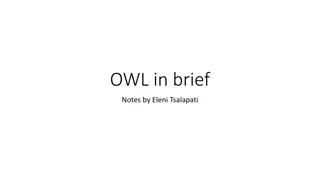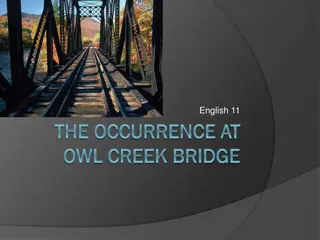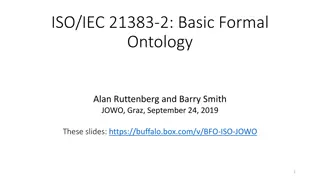Introduction to Developing OWL Ontologies with Protégé 4
Explore the world of developing OWL ontologies with Protégé 4 through a comprehensive tutorial by Simon Jupp and Timothy Redmond from Stanford Centre for Biomedical Research and the University of Manchester. Learn about OWL introduction, Protégé 4 interface, compositional approach, and the significance of using pizzas as a domain for ontology modeling. Delve into knowledge representation before OWL and understand the basics of the Web Ontology Language (OWL). Enhance your understanding of logical statements, description logic, and reasoning in ontology development.
Download Presentation

Please find below an Image/Link to download the presentation.
The content on the website is provided AS IS for your information and personal use only. It may not be sold, licensed, or shared on other websites without obtaining consent from the author.If you encounter any issues during the download, it is possible that the publisher has removed the file from their server.
You are allowed to download the files provided on this website for personal or commercial use, subject to the condition that they are used lawfully. All files are the property of their respective owners.
The content on the website is provided AS IS for your information and personal use only. It may not be sold, licensed, or shared on other websites without obtaining consent from the author.
E N D
Presentation Transcript
Developing OWL Ontologies with Prot g 4 Simon Jupp, Timothy Redmond, Stanford Centre for Biomedical Research, Stanford University tredmond@stanford.edu Bio-health Informatics Group, University of Manchester simon.jupp@manchester.ac.uk The University of Manchester Introduction to Ontologies Tutorial Creative Commons License
About this tutorial Quick tour of OWL Introduction to Prot g 4 interface How to build OWL ontologies in P4 Compositional approach Compositional lego The University of Manchester Creative Commons License
Why Pizzas? Pizzas have been used in Manchester tutorials for years. Pizzas were selected as a domain for several reasons: They are fun They are internationally known They are highly compositional They have a natural limit to their scope They are fairly neutral Although arguments still break out over representation Even pizzas can do this - its an inevitable part of knowledge modelling ARGUING IS NOT BAD! The University of Manchester Creative Commons License
Knowledge Representation before OWL Long history of Ontology development (predates computer science) Various ways to represent ontological structures Frames easy to understand, good infrastructure: problem - inflexible Semantic networks problem NO semantics! Different conclusions from different reasoners! Object Orientated Databases (O2) similar to Frames Description Logics Syntax consists of unary predicators, binary relations and a set of constructors e.g., LOOM, CLASSIC, DAML-OIL Latest standard OWL The University of Manchester Introduction to Ontologies Tutorial Creative Commons License
OWL (Web Ontology Language) Latest standard in ontology languages from the World Wide Web Consortium (W3C) Logic based ontology language OWL ontologies can be thought of as a set of logical statements #1: People attend Intro to OWL course #2: Simon attending Intro to OWL course Infer: Simon is a Person OWL corresponds to a highly expressive Description Logic Many construct (Intersection, conjunction, union and disjunction, negation or complement, and restrictions ) Each with a well defined formal meaning that facilitates reasoning The University of Manchester Introduction to Ontologies Tutorial Creative Commons License
What do we do with OWL? Semantic Web Creating a integrated Web of data Terminology building Can be simple is-a hierarchies Rich and highly axiomatised for complex reasoning OWL is used as a schema language e.g., Database alignment, Alternative to UML Ontology driven applications e.g., medical form generation Instance classification e.g., classifying proteins on functional groups Others??? . The University of Manchester Introduction to Ontologies Tutorial Creative Commons License
OWL Constructs Overview Person Country Elvis Belgium Holger Paraguay Class (concept, category, type) Kylie Latvia China S.Claus Hai Individual (instance) arrow = relationship label = Property Flipper Animal Rudolph The University of Manchester Introduction to Ontologies Tutorial Creative Commons License
More Information about OWL W3C OWL Web Site http://www.w3.org/2004/OWL/ CO-ODE Web Site http://www.co-ode.org Protege-OWL Web Site http://protege.stanford.edu/plugins/owl The University of Manchester Introduction to Ontologies Tutorial Creative Commons License
Overview Prot g Introduction Subsumption Creating a Class Hierarchy Consistency Disjointness Relationships & Properties Restrictions Polyhierarchies - Issues The University of Manchester Introduction to Ontologies Tutorial Creative Commons License
Is a knowledge modelling environment Is free, open source software Is developed by Stanford / Manchester Has a large user community (approx 30k) Prot g 4 built solely on OWL modelling language Supports development of plugins to allow backend / interface extensions The University of Manchester Introduction to Ontologies Tutorial Creative Commons License
Subsumption Superclass/subclass relationship, is-a All members of a subclass can be inferred to be members of its superclasses Thing: superclass of all OWL Classes A A subsumes B A is a superclass of B B is a subclass of A All members of B are also members of A B The University of Manchester Introduction to Ontologies Tutorial Creative Commons License
Labels so what? Humans might be able to interpret what the labels mean and how they are defined, but the computer cannot. Pizza A PizzaBase PizzaTopping B C D Names/labels alone only have meaning to humans (and are often ambiguous) The University of Manchester Introduction to Ontologies Tutorial Creative Commons License
Disjointness OWL assumes that classes overlap VegetableTopping FruitTopping = individual This means an individual could be both a VegetableTopping and a FruitTopping at the same time We want to state this is not the case The University of Manchester Introduction to Ontologies Tutorial Creative Commons License
Disjointness If we state that classes are disjoint VegetableTopping FruitTopping = individual This means an individual cannot be both a FruitTopping and a VegetableTopping at the same time We must do this explicitly in the interface How about TomatoTopping? The University of Manchester Introduction to Ontologies Tutorial Creative Commons License
Consistency Checking We ve just created two statements Fruit and vegetable toppings are different things Tomato is a type of both We d like to be able to check the logical consistency of our model This is one of the tasks that can be done automatically by software known as a Reasoner Being able to use a reasoner is one of the main advantages of using a logic-based formalism such as OWL (and why we are using OWL- DL) The University of Manchester Introduction to Ontologies Tutorial Creative Commons License
Reasoners and Protg Prot g -OWL supports the use of reasoners: Pellet, FaCT++ and Hermit This means that the reasoner you choose is independent of the ontology editor, so you can choose the implementation you want depending on your needs (e.g., some may be more optimised for speed/memory, others may have more features) The University of Manchester Introduction to Ontologies Tutorial Creative Commons License
Relationships in OWL In OWL-DL, relationships can only be formed between Individuals or between an Individual and a data value. Relationships are formed along Properties We can restrict how these Properties are used: Globally by stating things about the Property itself Or locally by restricting their use for a given Class The University of Manchester Introduction to Ontologies Tutorial Creative Commons License
OWL Properties Object Property Data-type Property Annotation Property The University of Manchester Introduction to Ontologies Tutorial Creative Commons License
Properties e.g., hasPart, isInhabitedBy, isNextTo, occursBefore Object Properties are used to relate Individuals We often say that Individuals are related along a given property Relationships in OWL are binary: Subject predicate Object Individual a hasProperty Individual b simon_jupp givesTalk k-cap_tutorial_2009 The University of Manchester Introduction to Ontologies Tutorial Creative Commons License
Types of Properties hasParent Inverse Matthew Dorothy hasChild Functional (also known as single valued properties) Peggy hasBirthMother Implies that Peggy and Margaret are the same individual Dorothy Margaret The University of Manchester Introduction to Ontologies Tutorial Creative Commons License
Other Types of Properties in OWL Inverse Functional Transitive Symmetric Asymmetric Reflexive Irrefelxive The University of Manchester Introduction to Ontologies Tutorial Creative Commons License
Restricting Classes with Properties We now have a property we want to use to describe Pizza individuals To do this, we must go back to the Pizza class and add some further information This comes in the form of Restrictions We create Restrictions using the Class Description View Conditions can be any kind of Class you have already added Named superclasses in the Class Description Frame. Restrictions are a type of Anonymous Class The University of Manchester Introduction to Ontologies Tutorial Creative Commons License
Existential Restrictions All Pizzas have a Topping which is a PizzaTopping Pizza has an existential restriction: hasTopping some PizzaTopping PizzaBase hasTopping PizzaTopping Pizza hasTopping X X = individual hasTopping The University of Manchester Introduction to Ontologies Tutorial Creative Commons License
Anonymous Classes We can talk about classes of things without explicitly naming them The University of Manchester Introduction to Ontologies Tutorial Creative Commons License
Primitive vs Defined Blue Things Smart Class Acts like a query Sharks Natural Kinds Like primitive, but also: define necessaryconditions that are also sufficient to recognise a member Eg have colour Blue All things that have colour blue are members of this class Describe the necessary features of the members Eg live underwater All sharks live underwater, but not everything that lives underwater is a shark The University of Manchester Introduction to Ontologies Tutorial Creative Commons License
CheesyPizza A CheesyPizza is any pizza that has some cheese on it We would expect then, that some pizzas might be named pizzas and cheesy pizzas (among other things later on) We can use the reasoner to help us produce this polyhierarchy without having to assert multiple parents The University of Manchester Introduction to Ontologies Tutorial Creative Commons License
Reasoner Classification The reasoner has been able to infer that anything that is a Pizza that has at least one topping from CheeseTopping is a CheesyPizza The inferred hierarchy is updated to reflect this and moved classes are highlighted in blue The University of Manchester Introduction to Ontologies Tutorial Creative Commons License
Why? Defined Classes Each set of Necessary & Sufficient conditions is an Equivalent Class Pizza hasTopping some CheeseTopping Pizza CheesyPizza CheesyPizza is equivalent to the intersection of Pizza and hasTopping some CheeseTopping Classes, all of whose individuals fit this definition are found to be subclasses of CheesyPizza, or are subsumed by CheesyPizza The University of Manchester Introduction to Ontologies Tutorial Creative Commons License
Defined Classes We ve created a Defined Class, CheesyPizza It has a definition. That is at least one Necessary and Sufficient condition Classes, all of whose individuals satisfy this definition, can be inferred to be subclasses Therefore, we can use it like a query to collect subclasses that satisfy its conditions Reasoners can be used to organise the complexity of our hierarchy It s marked with an equivalence symbol in the interface Defined classes are rarely disjoint The University of Manchester Introduction to Ontologies Tutorial Creative Commons License
Define a Vegetarian Pizza Not as easy as it looks Define in words? a pizza with only vegetarian toppings ? a pizza with no meat (or fish) toppings ? a pizza that is not a MeatyPizza ? More than one way to model this Let s model a Vegetarian Pizza The University of Manchester Introduction to Ontologies Tutorial Creative Commons License
Intersection Classes Intersection Classes are formed by combining two or more classes with the intersection (AND) operator. Male Human Intersection of Human and Male The University of Manchester Introduction to Ontologies Tutorial Creative Commons License
Union Classes aka disjunction This OR That OR TheOther B A or B includes all individuals of class A and all individuals from class B and all individuals in the overlap (if A and B are not disjoint) Commonly used for: A Covering axioms Closure The University of Manchester Introduction to Ontologies Tutorial Creative Commons License
Complement Classes A complement class is specified by negating another class. It will contain the individuals that are not in the negated class. Professor Woman Woman and (not Professor) The University of Manchester Introduction to Ontologies Tutorial Creative Commons License
DeMorgans Law not (A and B) = not A or not B not (A or (B and C) = not A and not (B and C) = not A and (not B or not C) not (hasTopping some X) = hasTopping only (not X) The University of Manchester Introduction to Ontologies Tutorial Creative Commons License
Universal Restrictions We need to say our VegetarianPizza can only have toppings that are vegetarian toppings We can do this by creating a Universal or only restriction We ll first look at an example The University of Manchester Introduction to Ontologies Tutorial Creative Commons License
What does this mean? We have created a restriction: hasBase only ThinAndCrispy on Class RealItalianPizza as a necessary condition RealItalianPizza ThinAndCrispy If an individual is a member of this class, it is necessary that it must only have a hasBase relationship with an individual from the class ThinAndCrispy The University of Manchester Introduction to Ontologies Tutorial Creative Commons License
What does this mean? We have created a restriction: hasBase only ThinAndCrispy on Class RealItalianPizza as a necessary condition RealItalianPizza DeepPan ThinAndCrispy No individual of the RealItalianPizza class can have a base from a class other than ThinAndCrispy NB. DeepPan and ThinAndCrispy are disjoint The University of Manchester Introduction to Ontologies Tutorial Creative Commons License
VegetarianPizza Classification Nothing classifies under VegetarianPizza Actually, there is nothing wrong with our definition of VegetarianPizza It is actually the descriptions of our Pizzas that are incomplete The reasoner has not got enough information to infer that any Pizza is subsumed by VegetarianPizza This is because OWL makes the Open World Assumption The University of Manchester Introduction to Ontologies Tutorial Creative Commons License
Open World Assumption In a closed world (like DBs), the information we have is everything In an open world, we assume there is always more information than is stated Where a database, for example, returns a negative if it cannot find some data, the reasoner makes no assumption about the completeness of the information it is given The reasoner cannot determine something does not hold unless it is explicitly stated in the model The University of Manchester Introduction to Ontologies Tutorial Creative Commons License
Open World Assumption Typically we have a pattern of several Existential restrictions on a single property with different fillers like primitive pizzas on hasTopping Existential restrictions should be paraphrased by amongst other things Must state that a description is complete We need closure for the given property The University of Manchester Introduction to Ontologies Tutorial Creative Commons License
Closure This is in the form of a Universal Restriction with a filler that is the Union of the other fillers for that property Closure works along a single property The University of Manchester Introduction to Ontologies Tutorial Creative Commons License
Primitive Classes All classes in our ontology so far are Primitive We describe primitive pizzas Primitive Class = only Necessary Conditions They are marked as plain orange circles in the class hierarchy We condone building a disjoint tree of primitive classes The University of Manchester Introduction to Ontologies Tutorial Creative Commons License
Asserted Polyhierarchies We believe asserting polyhierarchies is bad We lose some encapsulation of knowledge Why is this class a subclass of that one? Difficult to maintain Adding new classes becomes difficult because all subclasses may need to be updated Extracting from a graph is harder than from a tree Let the reasoner do it! The University of Manchester Introduction to Ontologies Tutorial Creative Commons License
What we havent done Cardinality Interesting Pizza equivalentTo Pizza that hasTopping min 4 PizzaTopping Datatypes LargePizza equivalentTo Pizza that hasDiameter > 12 Individuals ItalianPizza equivalentTo Pizza hasCountryOfOrigin value Italy OWL 2 The University of Manchester Introduction to Ontologies Tutorial Creative Commons License























